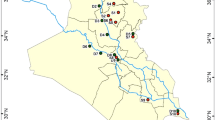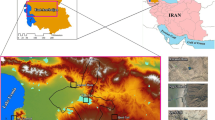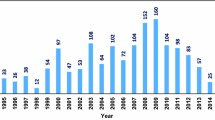Abstract
Dust storm is one of the most important environmental problems in the west of Iran. To indicate the environmental impact of these phenomena, the characterization of dust storm loads is vital. The objective of this study is to identify the mineralogical and chemical composition, trace elements, and microorganisms of dust particles deposited during a springtime dust storm event over the west of Iran to obtain total suspended particulate. Dust samples were collected from four cities in the west of Iran during dust storms in two spring seasons of 2011 and 2012. In addition to determining the sources of dust samples on the dates of sampling, synthetic approaches including remote sensing technique of dust detection, physical–meteorological model called HYSPLIT, and analysis of weather map were used. XRD analyses of airborne dust samples indicate that the mineralogy of airborne dusts is dominated by calcite and quartz; additionally, gypsum, albeit, muscovite, clinochlore, and dolomite are other minerals in springtime dust storm. XRF analyses indicate that the most important chemical components of airborne dusts are SiO2, CaO, Al2O3, Fe2O3, and MgO. The Atomic Absorption analysis was performed to determine the concentration of heavy metals including Fe, Cr, Pb, Zn, Cd, Co, Cu, and Ni. Concentration of heavy metals was Fe > Zn > Cr > Ni > Pb > Cu > Co > Cd, respectively, and average concentration of heavy metals on Middle East springtime dust storm (MESDS) occurrences were higher than values proposed by the World Health Organization. Microorganism analysis shows that the Bacillus species (41.25 %) is dominant, then Micrococcus (10.3 %), Staphylococcus sp. (7.61 %), Klebsiella (4 %), Escherichia coli (2.7 %), and Enterobacter sp. (1.8 %); Aspergillus sp. (21.07 %), Candida albicans (5.7 %), Rhizopus (2.24 %), Penicillium sp. (1.04 %), and Mucor (0.89 %) genera were fungal species that were isolated in the (MESDS). Basic sources for scattering of dust in the west and southwest of Iran are Iraqi desert, desert lands in the north and northeast of Arabian Peninsula, east and southeast of Syria, also occasionally Sahara desert and Khuzestan province in southwestern of Iran.







Similar content being viewed by others
References
Ackerman SA (1997) Remote sensing aerosols using satellite infrared observations. J Geophys Res 102:17069–17080
Al-Dabbas MA, Ayad Abbas M, Al-Khafaji RM (2010) Dust storms loads analyses—Iraq. Arab J Geosci 5(1):121–131
Al-Dousari AM, Al-Awadhi J, Ahmed M (2012) Dust fallout Characteristic within global dust storm major trajectories. Arab J Geosci. doi:10.1007/s12517-012-0644-0
Al-Hurban AE, Al-Ostad AN (2009) Textural characteristics of dust fallout and potential effect on public health in Kuwait City and suburbs. Environ Earth Sci 60:169–181
Al-Juboury AI (2009) Palygorskite in Miocene rocks of northern Iraq: environmental and geochemical indicators. Acta Geol Pol 59:269–282
Awad AHA (2007) Airborne dust, bacteria, actinomycetes and fungi at a flourmill. Aerobiologia 23:59–69
Awad AM, Mashat AWS (2013) Synoptic features associated with dust transition processes from North Africa to Asia. Arab J Geosci. doi:10.1007/s12517-013-0923-4
Amanollahi J, Kaboodvandpour S, Abdullah AM, Ramli MF (2011) Accuracy assessment of moderate resolution image spectroradiometer products for dust storms in semiarid environment. Int J Environ Sci Tech 8(2):373–380
Awadh SM (2011) Geochemistry and mineralogical composition of the airborne particles of sand dunes and dust storms settled in Iraq and their environmental impacts. Environ Earth Sci 66(8):2247–2256
Banerjee ADK (2003) Heavy metal levels and solid phase speciation in street dusts of Delhi in India. Environ Pollut 123:95–105
Bennion P, Richard H, O’Hara S, Wiggs G, Wegerdt J, Lewis S, Small I et al (2007) The impact of airborne dust on respiratory health in children living in the Aral Sea region. Int J Epidemiol 36:1103–1110
Boloorani AD, Nabavi SO, Azizi R, Bahrami HA (2012) Characterization of dust storm sources in Western Iran using a synthetic approach. Adv Meteorol Climatol Atmos Phys. doi:10.1007/978-3-642-29172-2
Changling H, Madsen HB, Awadzi TW (2007) Mineralogy of dust deposited during the Harmattan season in Ghana. Danish J Geogr 107(1):9–15
Chinnam N, Dey D, Tripathi SN, Sharma M (2006) Dust events in Kanpur, northern India: chemical evidence for source and implications to radiative forcing. Geophys Res Lett. doi:10.1029/2005GL025278
Draxler RR (2007) Demonstration of a global modeling methodology to determine the relative importance of local and long-distance sources. Atmos Environ 41:776–789
Engelstaedter S, Tegen I, Washington R (2006) North African dust emissions and transport. Earth Sci Rev 79:73–100
Engelbrecht JP, McDonald EV, Gillies JA, Jayanty RKM, Casuccio G, Gertler AW (2009) Characterizingmineral dusts and other aerosols fromtheMiddle East—part 2: grab samples and re-suspensions. Inhal Toxicol 21:327–336
Fairlie TD, Jacobb DJ, Parkb RJ (2007) The impact of transpacific transport of mineral dust in the United States. Atmos Environ 41:1251–1266
Fung I, Tegen I (1995) Contribution to the atmospheric mineral aerosol load from land surface modification. J Geophys Res 100:18707–18726
Gans J, Wolinsky M, Dunbar J (2005) Computational improvements reveal great bacterial diversity and high metal toxicity in soil. Science 309:1387–1390
Ganor E, Foner H (1996) The mineralogical and chemical properties and the behavior of Aeolian Saharan dust over Israel. In: Guerzoni S, Chester R (eds) The impact of desert dust across the Mediterranean. Kluwer, Amsterdam, pp 163–172
Goudie AS (2009) Dust storms: recent developments. J Environ Manage 90:89–94
Goudie AS, Middleton NJ (2006) Desert dust in the global system. Springer, Heidelberg, pp 287–288
Griffin DW (2007) Atmospheric movement of microorganisms in clouds of desert dust and implications for human health. Clin Microbiol Rev 20(3):459–477
Griffin DW, Kellogg CA, Garrison VH, Lisle JT, Borden TC, Shinn EA (2003) African dust in the Caribbean atmosphere. Aerobiologia 19:143–157
Griffin DW, Garrison VH, Herman JR, Shinn EA (2001) African desert dust in the Caribbean atmosphere: microbiology and public health. Aerobiologia 17:203–213
Hojati S, Khademi H, Faz Cano A, Landi A (2011) Characteristics of dust deposited along a transect between central Iran and the Zagros Mountains. Catena J 88:27–36
Hoult B, Tuxford AF (1991) Toxin production by Bacillus pumilus. J Clin Pathol 44(6):455–458
Huang J, Jinming G, Weng F (2007) Detection of asia dust storms using multisensor satellite measurements. Remote Sens Environ 110:186–191
Iranian Meteorological Organization (2012) Meteorological data from 1987–2012
Kakikawa M, Kobayashi F, Maki T, Yamada M, Higashi T, Chen B, Shi G, Hong CH, Tobo Y, Iwasaka Y (2008) Dustborne microorganisms in the atmosphere over an Asian dust source region, Dunhuang. Air Qual Atmos Health 1:195–202
Kalderon-Asael B, Erel Y, Sandler A, Dayan U (2009) Mineralogical and chemical characterization of suspended atmospheric particles over the East Mediterranean based on synoptic-scale circulation patterns. Atmos Environ 43:3963–3970
Kellogg CA, Griffin DW (2006) Aerobiology and the global transport of desert dust. Trends Ecol Evol 21:638–644
Khoshakhlagh F, Najafi MS, Samadi M (2012) An analysis on synoptic patterns of springtime dust occurrence in West of Iran. Geogr Res Q 2(80):99–124
Khoshhal Dastjerdi J, Mousavi SH, Kashki A (2012) Synoptic analysis of Ilam dust storms (1987–2005). Geogr Environ Plan 2(46):15–34
Kwon HJ, Cho SH, Chun Y, Lagarde AF, Pershagen G (2002) Effects of the Asian dust events on daily mortality in Seoul, Korea. Environ Res 9:1–5
Kwaasi AA (2003) Date palm and sandstorm-borne allergens. Clin Exp Allergy 33:419–426
Maghrabi A, Alharbi B, Tapper N (2009) Impact of the March 2009 dust event in saudi arabia on aerosol optical properties, meteorological parameters, sky temperature and emissivity. Atmos Environ 45:2164–2173
Meng Z, Lu B (2007) Dust events as a risk factor for daily hospitalization for respiratory and cardiovascular diseases in Minqin, China. Atmos Environ 41:331–343
Miri A, Ahmdi H, Ekhtesasi MR, Panjehkeh N, Ghanbarie A (2009) Environmental and socio-economic impacts of dust storms in Sistan Region, Iran. J Environ Stud 66:343–355
Modaihsh AS (1997) Characteristics and composition of the falling dust sediments in Riyadh city, Saudi Arabia. J Arid Environ 36:211–223
Morris CE, Sands DC, Bardin M, Jaenicke R, Vogel B et al (2011) Microbiology and atmospheric processes: research challenges concerning the impact of airborne micro-organisms on the atmosphere and climate. Biogeosciences 8:17–25
Notaro M, Alkolibi F, Fadda E, Bakhrjy F (2013) Trajectory analysis of Saudi Arabian dust storms. J Geophys Res Atmos. doi:10.1002/jgrd.50346
Poole K, McKay GA (2003) Iron acquisition and its control in Pseudomonas aeruginosa: many roads lead to Rome. Front Biosci 8:661–686
Prospero JM, Blades E, Naidu R, Mathison G, Thani H, Lavoie MC (2008) Relationship between African dust carried in the Atlantic trade winds and surges in pediatric asthma attendances in the Caribbean. Int J Biometeorol 52:823–832
Rashki A, Kaskaoutis DG, Rautenbach CJW, Eriksson PG, Qiang M, Gupta P (2012) Dust storms and their horizontal dust loading in the Sistan region, Iran. Aeolian Res 5:51–62
Rashki A, Eriksson PG, Rautenbach CJW, Kaskaoutis DG, Grote W, Dykstra J (2013) Assessment of chemical and mineralogical characteristics of airborne dust in the Sistan region-Iran. Chemosphere 90(2):227–236
Rosas I, Salinas E, Yela A, Calva E, Eslava C, Cravioto A (1997) Escherichia coli in settled-dust and air samples collected in residential environments in Mexico City. Appl Environ Microbiol 63(10):4093–4095
Razos P, Christides A (2010) An investigation on heavy metals in an industrial area in Greece. Int J Environ Res 4:785–794
Raespour K (2008) Statistical and synoptical analysis of dust phenomena in Khuzestan providence. MA Thesis, Sistan and Balouchestan University, pp 166
Samadi M (2011) Dust storm detection and source identification by using satellite imagery. MA Thesis, University of Tehran, pp 106
Shahsavani A, Naddafi K, Haghighifard NJ, Mesdaghinia A, Yunesian M et al (2012) Characterization of ionic composition of TSP and PM10 during the Middle Eastern Dust (MED) storms in Ahvaz, Iran. Environ Monit Assess 184(11):6683–6692
Shao LY, Li W, Yang SH, Shi Z, Lu S (2007) Mineralogical characteristics of airborne particles collected in Beijing during a severe Asian dust storm period in spring 2002. Sci China Ser D-Earth Sci 50(6):953–959
Shen Z, Cao J, Arimoto R, Han Z, Zhang R, Han Y et al (2009a) Ionic composition of TSP and PM2.5 during dust storms and air pollution episodes at Xi’an, China. Atmos Environ 43(18):2911–2918
Shen ZX, Caquineauc S, Caoa J, Zhangb X, Hana Y, Gaudichetd A, Gomese L (2009b) Mineralogical characteristics of soil dust from source regions in northern China. Particuology 7:507–512
Shen ZX, Cao JJ, Arimoto R, Zhang RJ, Jie DM, Liu SX, Zhu CS (2007) Chemical composition and source characterization of spring aerosol over Horqin sand land in northeastern China. J Geophys Res. doi:10.1029/2006JD007991
Shi Z, Shao L, Jones T, Lu S (2005) Microscopy and mineralogy of airborne particles collected during severe dust storm episodes in Beijing, China. J Geophys Res. doi:10.1029/2004 JD005073
Singer A (1989) Palygorskite and sepiolite group minerals. In: Dixon J, Weed S (eds) Minerals in soil environments. Soil Science Society of America, Madison, pp 829–872
Singer A, Ganor E, Dultz S, Fischer W (2003) Dust deposition over the Dead Sea. J Arid Environ 53:41–59
Sokolic IN, Toon OB, Bergstrom RW (1998) Modeling of radiative characteristics of airborne mineral aerosols at infrared wavelengths. J Geophys Res 103:8813–8826
Shadfan H, Dixon JB (1984) Occurrence of palygorskite in the soils and rocks of the Jordan Valley. In: Singer A, Galán E (eds) Palygorskite–Sepiolite: occurrences, genesis and uses. Elsevier, Amsterdam, pp 187–198
Shadfan H, Mashhady AS, Dixon JB, Hussen AA (1985) Palygorskite from tertiary formations eastern Saudi Arabia. Clays Clay Miner 33:451–457
Ta W, Xiao H, Qu J, Xiao Z, Yang G, Wang T, Zhang X (2004) Measurements of dust deposition in Gansu Province, China, 1986–2000. Geomorphology 57:41–51
Toon OB (2003) African dust in Florida clouds. Nature 424:623–624
Velde B (1995) Origin and mineralogy of clays: clays and the environment. Springer, Berlin, 88 pages
Wang S, Wang J, Zhou Z, Shang K (2005) Regional characteristics of three kinds of dust storm events in China. Atmos Environ 39(3):509–520
Xia L (2010) Sea surface temperature extraction by MODIS remote sensing data in Lianyungang sea area. Second IITA Int Conf Geosci Remote Sens 1:118–120
Yao X, Chan CK, Fang M, Cadle S, Chan T, Mulawa P et al (2002) The water-soluble ionic composition of PM2.5 in Shanghai and Beijing, China. Atmos Environ 36:4223–4234
Zarasvandi A, Carranza EJM, Moore F, Rastmanesh F (2011) Spatio-temporal occurrences and mineralogical–geochemical characteristics of airborne dusts in Khuzestan Province (southwestern Iran). J Geochem Explor 111:138–151
Zhu A, Ramanathan V, Li F, Kim D (2007) Dust plumes over the Pacific, Indian, and Atlantic Oceans: climatology and radiative impact. J Geophys Res. doi:10.1029/2007JD008427
Author information
Authors and Affiliations
Corresponding author
Rights and permissions
About this article
Cite this article
Najafi, M.S., Khoshakhllagh, F., Zamanzadeh, S.M. et al. Characteristics of TSP Loads during the Middle East Springtime Dust Storm (MESDS) in Western Iran. Arab J Geosci 7, 5367–5381 (2014). https://doi.org/10.1007/s12517-013-1086-z
Received:
Accepted:
Published:
Issue Date:
DOI: https://doi.org/10.1007/s12517-013-1086-z




